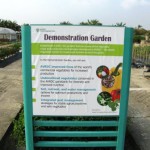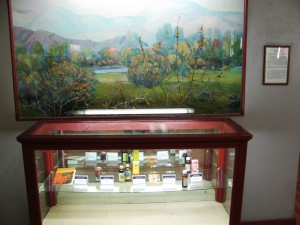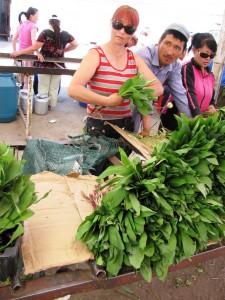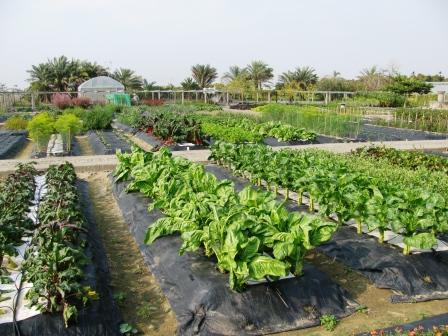- Cary Fowler on the need to breed.
- MRIs of fruits and vegetables. Well, why not?
- The genetic consequences of bovine inter-specific sex explained. SFW.
- How Mrs Joséphine Enoce Bouanga makes milk from squash seeds in Pointe-Noire.
- Gates Foundation orange sweet potato project in Mozambique. Still waiting to hear what they’re going to do with all those useless landraces they’ll be replacing.
- Nourishing the Future does Lost Crops of Africa 101. Beginners, start there, but don’t expect to be taken anywhere interesting.
- Blog carnival Scientia Pro Publica #35 is up, but what’s with the verse alphabetical order? Harummph.
AVRDC’s treasure trove of diversity
I was recently at AVRDC headquarters in Taiwan and was quite taken with their demonstration garden. (Among other things. The genebank operation is also impressive, and recovering from a recent unfortunate setback.) It’s a wonderful display of both vegetable diversity and cultivation systems. I was going to blog about it, but then life intervened, or at least work did. Anyway, the latest issue of AVRDC’s newsletter has a piece on the garden, and they have kindly agreed for us to reprint it here, as the newsletter itself is not available online. Which kinda gets me off the hook. The photographs are mine. The following text (and this post’s title) are courtesy of AVRDC.
Although there are thousands of plants people can consume, humanity relies on only a relative handful for food. Indigenous vegetables — whether semi-wild or domesticated — can greatly expand the menu. Grown primarily in their centers of origin or introduced in a given area, indigenous or traditional vegetables provide food in times of scarcity for the world’s poorest people, yet these hardy, nutritious species often are underutilized.

What began in 2001 as an experimental field on the grounds of the AVRDC headquarters campus in Shanhua, Taiwan has blossomed into a 0.63-hectare living example of the mission and work of AVRDC — The World Vegetable Center.
“The Demonstration Garden was designed as an observation plot for indigenous vegetables when we got the project from the Taiwan Council of Agriculture in the beginning,” said Mandy Lin, an assistant specialist in AVRDC Global Technology Dissemination. After 10 years of development, more than 60 different species of indigenous vegetables are cultivated in 200 plots of various sizes and shapes to showcase the special qualities of each species and promote their wider use. The range of species grown also maintains visual interest as the seasons change.
The indigenous vegetables in the garden were selected for three significant characteristics—ease of cultivation (low input), nutritional quality, and resistance to pests and diseases. Visitors touring the Demonstration Garden often are surprised by the number and variety of indigenous vegetables, and the different edible parts, from shoots and leaves to pods and seeds. “We want to convey a simple but principal message to every visitor—that a diverse diet including many different vegetables is beneficial to health,” Mandy said.
In July 2008 the Center’s Global Technology Dissemination group expanded the function of the Demonstration Garden to highlight four major mature technologies: low-cost drip irrigation, starter solution, grafting chambers, and protective shelters. Farmers in developing countries can adopt these technologies to increase yields, improve produce quality, and reduce production costs.

Visitors and AVRDC staff members alike gain new ideas and inspiration as they walk through the garden, enjoy the rich diversity of plants, and see farming technologies in use. As Mandy observed: “You think you are taking care of crops, but in fact they educate you with their beauty and variety.”
Sea buckthorn becoming a success in a land with no sea
The name of the game in Mongolian agriculture is diversification. And one of the things researchers at PSARTI, the Plant Science Research and Training Institute in Darkhan, and others are looking at is a shrubby berry called sea buckthorn (Hippophae rhamnoides) with some interesting nutritional properties. They have put together a small germplasm collection of local and introduced material and are doing agronomic trials of various kinds, trying to find the best varieties for different purposes. In fact, the plant has a pretty long and rich history in Mongolia:
It is said that Genghis Khan, the Mongol conqueror, who established one of the largest empires from China to Eastern Europe in the 13th century, relied on three treasures: well organized armies, strict discipline and Seabuckthorn. Seabuckthorn berries and seed oil made Genghis Khan’s soldiers stronger than his enemies.
There are already some products on the market. Like this delicious icecream, called Ice Doctor.

The natural history museum in downtown Ulaanbaatar has a display featuring a number of locally-made products — a couple of different oils and “globules” — along with a somewhat threadbare diorama.

I guess commercialization still has some way to go, but a start has been made. Another wild species with some commercial potential may be strawberries.

Wild Allium of various kinds is also sold in the market.

Nibbles: Ecosystems, Coops, Cacao, Agroforestry
- Focus on ecosystem conservation: grasslands in South Africa, mangroves around the world.
- FAO says cooperatives are good for you.
- Great set of cacao photos from Sustainable Harvest International.
- Video Q&A on agroforestry with Dr Dennis Garrity, Director General of ICRAF.
Nibbles: FAOSTAT, Drought, Seeds, Helianthus, Coffee trade, CePaCT, Figs, Old rice and new pigeonpea, Navajo tea, Cattle diversity, Diabetes, Art, Aurochs, Cocks
- FAO sets data free. About time.
- Presentation on drought risk and preparedness around the world. Nice maps.
- A Facebook for seeds?
- The diversity of Jerusalem artichoke. In France.
- Coffee certification 101.
- Nice plug for SPC’s Centre for Pacific Crops and Trees.
- The fig of choice in San Francisco.
- Back to traditional rice varieties in India. But forward to new pigeonpea varieties in Malawi. Go figure.
- Navajo tea. Would love to try it.
- “The mixed (east-west) affiliation of Mongolian cattle parallels the mixed affiliation of Mongolians themselves.”
- Lancet article mentions Lois Englberger and her Go Local work in the Pacific in context of diabetes epidemic in Asia-Pacific.
- Edible art.
- More on bringing back the aurochs. Does anyone really want one, though?
- Great variety of rare and exotic poultry breeds. Temptation to pun smuttily averted, mostly.
